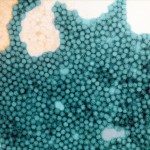Lien vers Pubmed [PMID] – 16912307
J. Virol. 2006 Sep;80(17):8582-92
PML nuclear bodies (NBs) are dynamic intranuclear structures harboring numerous transiently or permanently localized proteins. PML, the NBs’ organizer, is directly induced by interferon, and its expression is critical for antiviral host defense. We describe herein the molecular events following poliovirus infection that lead to PML-dependent p53 activation and protection against virus infection. Poliovirus infection induces PML phosphorylation through the extracellular signal-regulated kinase pathway, increases PML SUMOylation, and induces its transfer from the nucleoplasm to the nuclear matrix. These events result in the recruitment of p53 to PML NBs, p53 phosphorylation on Ser15, and activation of p53 target genes leading to the induction of apoptosis. Moreover, the knock-down of p53 by small interfering RNA results in higher poliovirus replication, suggesting that p53 participates in antiviral defense. This effect, which requires the presence of PML, is transient since poliovirus targets p53 by inducing its degradation in a proteasome- and MDM2-dependent manner. Our results provide evidence of how poliovirus counteracts p53 antiviral activity by regulating PML and NBs, thus leading to p53 degradation.
